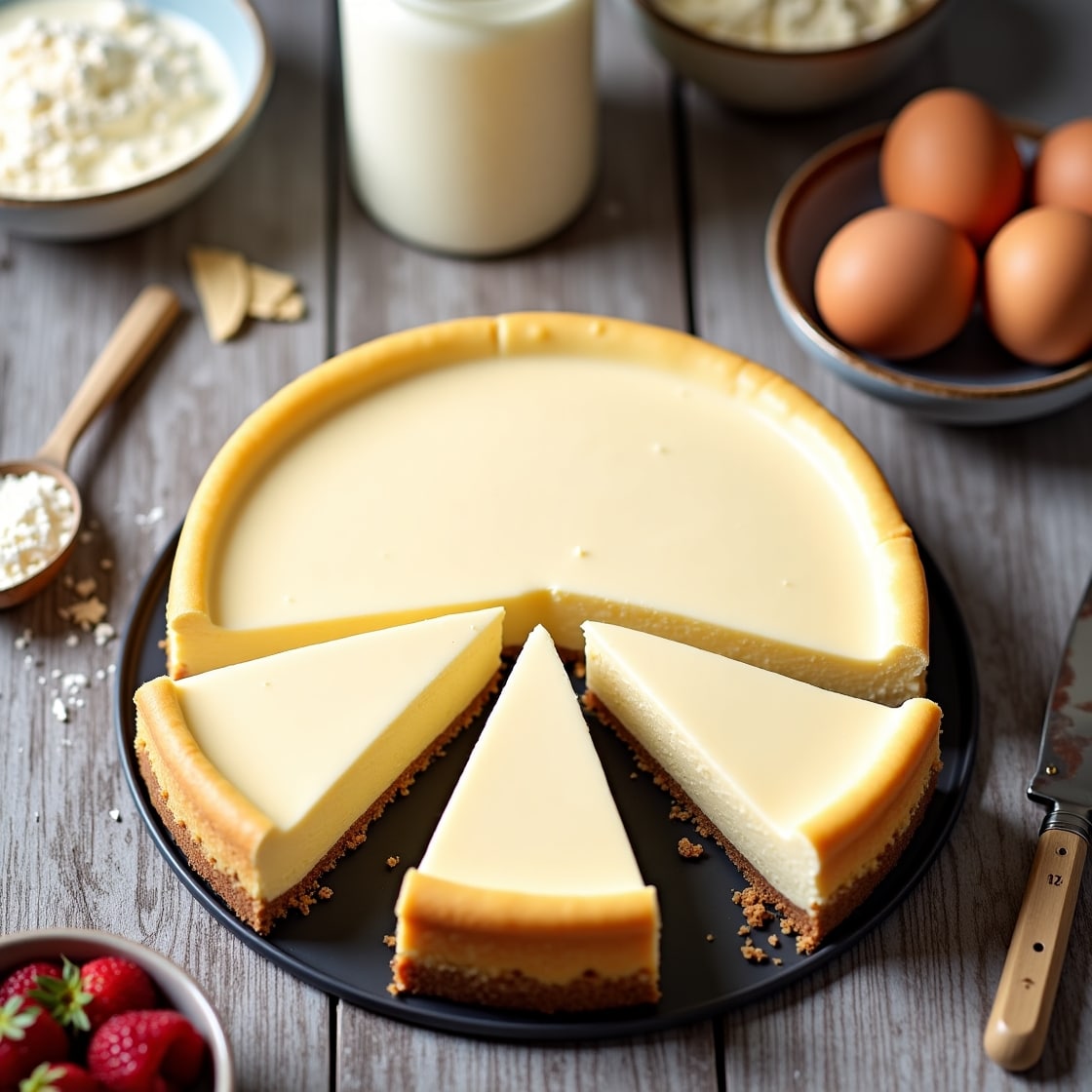Introduction
Craving something sweet without sabotaging your protein goals? A high protein cheesecake might just be your new best friend. It delivers the indulgent flavor of classic cheesecake with a powerful protein punch that fits perfectly into a balanced diet. In this article, you’ll discover how to make a delicious, creamy high protein cheesecake that feels like dessert but performs like fuel. From why it works nutritionally to recipe tips and protein-packed alternatives, we’re diving deep into this game-changing dessert. If you’re looking for dessert with benefits, this is it. Let’s dig into the sweet science and joy of high protein cheesecake.
Table of Contents
Table of Contents
The Story & Intro to High Protein Cheesecake
Why I Swapped Classic Cheesecake for a Protein-Packed Twist
Let me tell you about the time I tried making a high protein cheesecake for the first time. My teenage son had just started going to the gym, and suddenly we had tubs of protein powder taking over the pantry. One afternoon, I spotted a block of cream cheese nearing its expiry and a tub of Greek yogurt staring at me accusingly. That’s when the idea hit me. Why not experiment with a cheesecake that wouldn’t leave us in a sugar crash coma? To my surprise, it wasn’t just decent—it was downright delicious. What really amazed me was that everyone thought it was the real deal, not a healthier version.
That success kicked off my obsession with giving traditionally indulgent recipes a nutritious upgrade. My high protein cheesecake is creamy, tangy, lightly sweet, and incredibly satisfying. It’s perfect as a post-dinner treat or even a sneaky breakfast. Yes, I’ve done it. And unlike most “diet desserts,” this one doesn’t taste like a compromise.

What Makes Cheesecake a Protein Powerhouse
A typical cheesecake isn’t exactly known for its protein. But swap out the heavy cream and sugar for high-protein ingredients like cottage cheese, Greek yogurt, or protein powder, and you’ve got yourself a macro-friendly dessert that helps with satiety and muscle repair.
I use low-fat cream cheese and unflavored whey protein to keep the flavor classic but clean. Greek yogurt adds a tangy creaminess that balances sweetness without overloading the sugar. This combo creates a satisfying dessert that feels like a treat, not a trade-off.
If you’re following a high-protein diet or just want more balance in your meals, desserts like this can fill the gap beautifully. You might also enjoy the high protein cucumber salad or protein bagels recipe for more inspiration.
Cheesecake That Loves Your Goals Back
A high protein cheesecake isn’t just delicious. It’s practical. It fits into meal plans ranging from calorie deficit to muscle building. Each slice can pack 10 to 20 grams of protein depending on your ingredients, making it one of the best protein-rich desserts around. When I served it after Sunday roast once, even my skeptical husband said, “I thought this was just cheesecake.”
That’s the goal. To make something real, satisfying, and comforting. No weird textures. No “diet food” guilt. Just a luscious slice of something that makes you smile and supports your health goals. For me, that’s the heart of what good home cooking should be.
Print
High Protein Cheesecake: A Guilt-Free Slice of Heaven
- Total Time: 55 minutes
- Yield: 8 slices 1x
Description
This high protein cheesecake is rich, creamy, and packed with over 20g of protein per slice. Perfect for healthy desserts, meal prep, or post-workout fuel.
Ingredients
1 cup Greek yogurt (plain, full-fat or 2%)
8 oz low-fat cream cheese
1 cup low-fat cottage cheese
2 scoops vanilla or unflavored whey protein
2 large eggs
1/3 cup erythritol or preferred sweetener
2 tsp vanilla extract
Crust: 1 cup almond flour, 2 tbsp melted coconut oil, 1 tbsp sweetener
Instructions
1. Preheat oven to 325°F (160°C).
2. Mix crust ingredients, press into lined 8-inch springform pan, and bake for 8–10 minutes. Cool.
3. Blend all filling ingredients until smooth.
4. Pour batter into crust and gently shake to remove bubbles.
5. Bake 40–50 minutes until edges are set and center slightly jiggles.
6. Turn off oven, crack door, and cool cheesecake slowly inside.
7. Refrigerate 4 hours or overnight before serving.
Notes
Can be made crustless in ramekins.
Add fruit or nut toppings just before serving.
Freezes well when wrapped individually.
- Prep Time: 10 minutes
- Cook Time: 45 minutes
- Category: Dessert
- Method: Baking
- Cuisine: American
Nutrition
- Serving Size: 1 slice
- Calories: 210
- Sugar: 2g
- Sodium: 180mg
- Fat: 11g
- Saturated Fat: 5g
- Unsaturated Fat: 5g
- Trans Fat: 0g
- Carbohydrates: 9g
- Fiber: 2g
- Protein: 21g
- Cholesterol: 55mg

Key Ingredients That Make High Protein Cheesecake Work
Choosing the Right Protein-Rich Ingredients
To create a high protein cheesecake that doesn’t taste like a compromise, the secret is in your base ingredients. Classic cheesecake relies heavily on full-fat cream cheese, sugar, and sometimes sour cream. While rich, those ingredients don’t support a high-protein diet. Luckily, some smart swaps can keep the creaminess without sacrificing flavor.
Greek yogurt is one of my go-to ingredients. It’s thick, tangy, and loaded with protein. Choose plain, full-fat or 2% depending on your goals. Cottage cheese is another secret weapon. When blended, it becomes smooth and almost identical in texture to cream cheese but with less fat and more protein. Low-fat cream cheese still adds that familiar richness, and when used with the others, it strikes a perfect balance.
And yes, protein powder can absolutely go into cheesecake. I use an unflavored or vanilla whey isolate for the best results. It blends seamlessly without making the batter gritty or overly dense. If you’re sensitive to whey, plant-based options work too, though they might alter the texture slightly.
You’ll also need eggs, a small amount of natural sweetener like stevia or erythritol, and a splash of vanilla extract. That’s really it. The recipe is simple and surprisingly forgiving. For a soft, lightly sweet crust, you can use almond flour mixed with a bit of melted coconut oil and sweetener.
Looking for a crustless or even flourless twist? Try this in mini ramekins for portioned, crust-free cheesecake pots. I sometimes make a few of these to pair with cottage cheese bagels as part of a protein-packed brunch.
Tasty Swaps to Fit Your Diet Goals
You can easily tailor this cheesecake to fit your nutrition preferences. Need it dairy-free? Use a dairy-free Greek-style yogurt and plant-based cream cheese. Just watch the labels—some alternatives are lower in protein. A good coconut-based yogurt with added pea protein can give a similar creamy body.
For keto lovers, swap sweeteners with monk fruit or erythritol blends and stick to full-fat dairy. If you’re all about calories and gains, add a scoop of peanut butter to the batter for a nutty twist. I’ve also mixed in crushed berries, cocoa powder, and even espresso for flavor variety.
Don’t be afraid to play with toppings either. A drizzle of sugar-free dark chocolate or a spoonful of fruit compote makes it feel even more indulgent without sabotaging your macros. And if you’re short on time, this can double as a no-bake recipe by simply chilling the blended filling in a prepared almond flour crust.
Try pairing this dessert with a slice of easy carrot cake cheesecake when you want to impress guests or just treat yourself to a protein-rich variety plate.
How to Make High Protein Cheesecake Step by Step
Simple Steps to a Creamy, Protein-Packed Cheesecake
Baking a high protein cheesecake isn’t much different from making a traditional one. The key is to mix everything smoothly and bake it low and slow. You don’t need a fancy mixer, just a blender or food processor and a bit of patience.
Start by preheating your oven to 325°F. For the crust, combine 1 cup almond flour with 2 tablespoons melted coconut oil and 1 tablespoon sweetener. Press this into the base of a lined 8-inch springform pan. Bake it for 8 to 10 minutes until lightly golden, then let it cool.
Now, onto the filling. In a blender, combine 1 cup low-fat cottage cheese, 1 cup Greek yogurt, 8 oz low-fat cream cheese, 2 eggs, 2 scoops vanilla or unflavored whey protein, 1/3 cup sweetener of choice, and 2 teaspoons vanilla extract. Blend until smooth and creamy.
Gently spoon the batter into the crust, smoothing the top evenly. Give the pan a light shake to bring any bubbles to the surface. Bake for 40 to 50 minutes until set. he cheesecake will look firm around the edges but should wobble slightly in the middle when gently nudged. Once the baking time is up, switch off the oven and let the cheesecake rest inside with the door slightly open. This slow cooling step reduces the chance of cracks forming.
Once cooled, chill the cheesecake in the fridge for at least 4 hours, preferably overnight. That chilling time allows the cheesecake to set properly while the flavors mellow and blend beautifully.. That first chilled slice is always the best.
This method also works well for mini cheesecakes using muffin tins. I often make a batch of these when prepping meals like chicken pesto bakes, giving us a savory main and a sweet finish that both hit the protein mark.
How to Store, Freeze, and Serve for Maximum Freshness
Store your high protein cheesecake in the refrigerator, covered tightly, and it will stay fresh for around five days.Your high protein cheesecake will keep in the fridge for up to five days, covered. I usually cut it into single portions and pack them in sealed containers, making it easy to enjoy after a workout or during a snack craving.strikes.
You can also freeze it. Individually wrap each slice in parchment, then place them in freezer-friendly containers or zip-top bags for easy storage. Thaw them overnight in the fridge or microwave gently for a quick dessert fix. The texture stays surprisingly creamy, even after freezing.
Top your cheesecake just before serving to keep things fresh. Try fresh berries, a spoonful of Greek yogurt, or even a few chopped nuts. If you’re craving something extra decadent but still balanced, pair it with a slice of easy chocolate ricotta brick cake. The contrast in textures is incredible.
I love serving this cheesecake at brunches or meal prep days. It feels like a treat but works perfectly into your weekly routine. Up next, we’ll look at common questions people ask about protein cheesecake and alternatives that can help fit different dietary needs.

FAQs About High Protein Cheesecake and Smart Substitutions
Is a cheesecake high in protein?
Traditional cheesecake isn’t considered high in protein. It’s usually made with full-fat cream cheese, sugar, and sometimes heavy cream, which are low in protein and high in fat and carbs. By swapping in ingredients such as Greek yogurt, cottage cheese, or a scoop of protein powder, you can significantly boost the protein content of your cheesecake. A slice of high protein cheesecake can deliver 10 to 20 grams of protein depending on the recipe, making it an excellent dessert option for those trying to increase their protein intake.
Can I put protein powder in cheesecake?
Definitely. Cheesecake batter can easily handle protein powder, particularly smooth-blending types like whey or casein.Choose vanilla or unflavored varieties to maintain a balanced flavor, and keep an eye on your measurements to avoid overpowering the cheesecake. Using too much can lead to a dense, slightly gritty texture that takes away from the creaminess you want in a cheesecake. Two scoops are usually the sweet spot for an 8-inch cheesecake. If you’re unsure where to start, the base recipe we use works beautifully and holds its shape without drying out.
Adding protein powder is a great way to boost the nutritional profile of desserts like easy blueberry coffee cake or even muffins. Just make sure to rebalance moisture with ingredients like yogurt or applesauce when adjusting other baked goods.
Which dessert has the most protein?
Among desserts, high protein cheesecake is one of the leaders when it comes to protein content per serving. Protein-rich puddings, mug cakes, and protein brownies come close, but cheesecake wins for its balance of macros and rich texture. Some recipes even beat out protein bars in terms of nutrition and taste. Another bonus is that cheesecake feels like a real dessert rather than something “functional.”
To take it further, try a protein cheesecake layered with oats or topped with a dollop of nut butter. These little touches add variety while keeping the dessert high in both flavor and fuel.
What is a high protein alternative to cream cheese?
If you’re looking for alternatives to traditional cream cheese that still keep protein levels high, here are a few top picks:
Cottage cheese: When blended, it mimics the texture of cream cheese and has more protein with less fat.
Greek yogurt: Thick, tangy, and easy to blend into cheesecake bases.
Skyr: An Icelandic dairy product similar to yogurt, with even more protein.
Neufchâtel: A lower-fat cheese similar to cream cheese, slightly higher in protein.
Each of these can be used alone or combined depending on the flavor and texture you’re aiming for. They’re also great in savory applications like dips, spreads, or even in recipes like cottage cheese bagels when you want to double down on the protein theme.
Whether you’re baking for muscle-building goals or just want a better-for-you dessert, high protein cheesecake lets you have your slice and eat it too. It’s flexible, satisfying, and anything but boring.
Conclusion: A Sweet Way to Stay on Track
High protein cheesecake is proof that dessert doesn’t have to be the enemy of your health goals. With the right ingredients and simple techniques, you can enjoy all the indulgent flavor of traditional cheesecake while fueling your body with quality protein. Whether you’re meal prepping for the week or bringing a dessert to a get-together, this recipe delivers both flavor and function.
It’s become a staple in our house. My teens love it, my husband asks for it by name, and I always smile knowing it started with a bit of curiosity and a fridge full of leftovers. If you’re nervous about baking with protein powder or switching up your usual dessert habits, give this a try. It’s forgiving, flexible, and surprisingly fun to make.
Pair it with one of our easy protein-packed recipes or enjoy it solo as a guilt-free treat. Once you’ve tasted how good healthy can be, you won’t want to go back.
If I can make it, you can too. Let’s keep cooking smart, simple, and a little bit sweet.

10 thoughts on “High Protein Cheesecake – Ultimate Guilt-Free Dessert with 20g Protein”